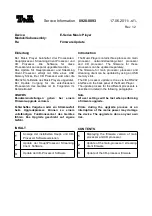
like this for a full 20 seconds before the music started.
I got similar results with SACD material and DVD-A
sources often took even longer. One, Big Phat Band’s
Swingin’ for the Fences
(Silverline DVD-A 82002) took
a full 35 seconds, because the player actually had to
access two menus (automatically bypassing the first
after pulling it up) before the disc started to play. It is
not a great big deal, and probably involves the player’s
ability to deal with so many different kinds of
recordings. However, some users might wonder if the
player is having some kind of initial hang-up problem
when playing CDs or any other audio-only source
materials.
In addition, after installing a disc most CD players
and other DVD players give a total-time readout on
their front panels and then go into a hold mode and
wait for the operator to press play. In contrast, when a
CD is first installed in the DVD-S1500 no total-time
readout appears and the player begins playing after
the lengthy cue-up procedure. This is not all that
critical (unless you are a reviewer wanting to put total-
play-time information into his review and it is not
included on the CD box information package), but it
might bother some users. Sure, I can turn on the TV to
get the on-screen menu info, but who wants to turn
on a big-screen TV monitor just to get total-time info
about a CD?
Player idiosyncrasies aside, for most of us audio
nerds the big deal with this player will be SACD and
DVD-A performance. Unfortunately, both of those
formats are nearly stalled when it comes to marketing,
and it is quite possible that they will never amount to
much more than niche formats. It is also possible that
they both may end up being involved in a long and
drawn out DOA situation, at least when compared to
hotshot technologies like the CD, DVD-video, and
MP3.
If we are going to discuss DVD-A and SACD
as practical technologies instead of their sales successes
or failures, we first need to come to grips with the bass
management and distance compensation issues that
involve the DVD-S1500. This can be important, because
most surround processors and receivers do not offer
these emendations with their 6-channel analog inputs.
The signals are passed through unaltered.
With the DVD-S1500 you get full bass
management from the six-channel (5.1) analog outputs
with SACD source material. The subwoofer crossover
points and slopes are user selectable: 60, 80, 100, and
120 Hz, with slopes of 12, 18, and 24 dB per octave.
This is a great feature for those with sub/sat systems
that have smallish satellite speakers. For those with
full-range satellite speakers in combination with a
subwoofer, the player offers an SACD “direct” mode
that automatically bypasses all bass-management
settings from the six-channel outputs. I really like these
options.
Unfortunately, there is no bass management with
DVD-A source material, no matter what speaker-size
settings you choose from the player’s menu, meaning
that if you use the above-noted (and typical) small-
satellite sub/sat system the small satellites will be
getting full-bandwidth bass right along with the
subwoofer. Strangely enough, there is also no bass
management with CD source material when using the
six-channel output’s stereo-only mode, although the
DPL II mode, which is a more viable option in every
way I can think of, does manage the bass.
Fortunately, full-bandwidth signals from the
player’s standard two-channel outputs from CD
sources also allow one’s receiver to apply bass
management in the usual manner. Interestingly, with
the six-channel outputs playing CD and DVD source
material you do get the ability to independently
balance the volume levels on each channel. However,
you do not get this with SACD sources.
While DVD-A is shortchanged when it comes to
bass management, it is SACD that is shortchanged with
distance compensation. DVD-A gets the ability to
adjust for different speaker distances to the listening
position and full compensation abilities are also
provided for DD and DTS sources. SACD gets no
compensation at all. For it to work at its best with
SACD, the five satellite speakers all need to be similar
distances from the prime listening location. This is a
weird situation and is probably related to the political
machinations that occurred when the parameters for
these new technologies were being worked out.
I mentioned above that most processors or
receivers do not offer bass management or distance
compensation with their six-channel analog inputs.
Even the Yamaha RX-Z1 receiver I reviewed in issue
93 lacks these features, because it does its bass
management in the digital domain, independently
from the six-channel analog inputs. It manages bass
from standard, two-channel analog inputs, because
those are digitized prior to being run through the
amplification and any DSP surround functions.
However, the six-channel analog inputs are run
directly to the amp sections via the volume-control
circuits.
One exception to the bass-management situation
with receivers and processors (there are more
exceptions, I am sure, but I have no experience with
them) is the above-mentioned Yamaha DSP-A1
integrated amp that I use in my middle system. That
unit does its bass managing in the analog domain, after
digitizing and DSP operations are completed and the
signals converted back to analog prior to basic
amplification. When you set up the DSP-A1 to bass
manage digitally connected DD and DTS sources after
they are converted back to analog for amplification it
also applies the same manipulations with the six-
channel analog inputs.


























